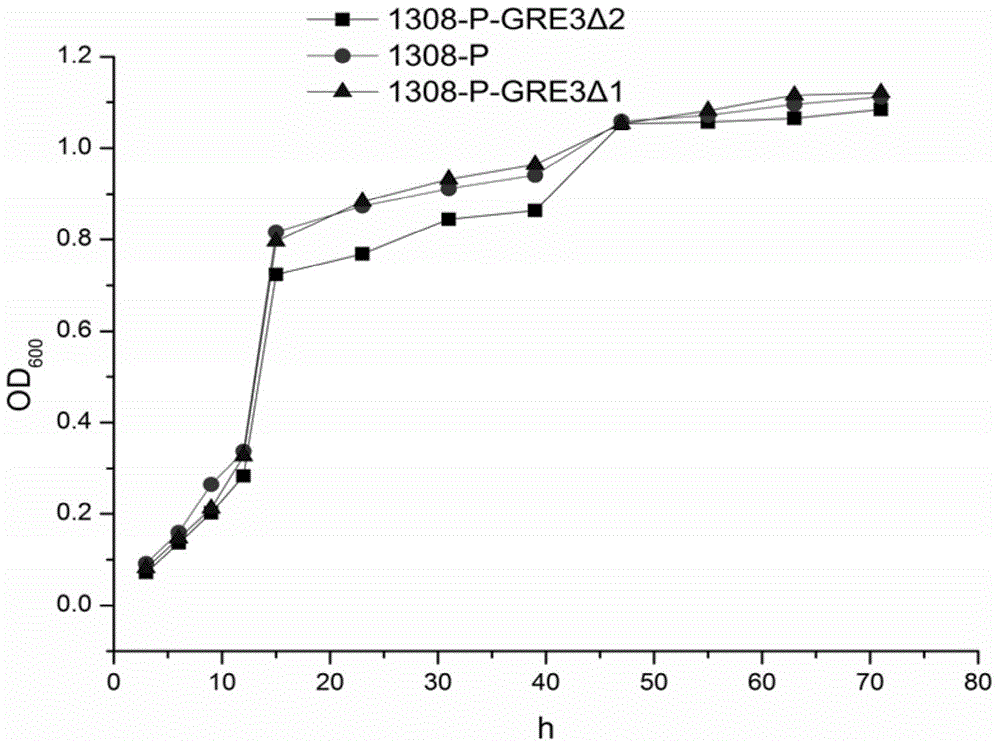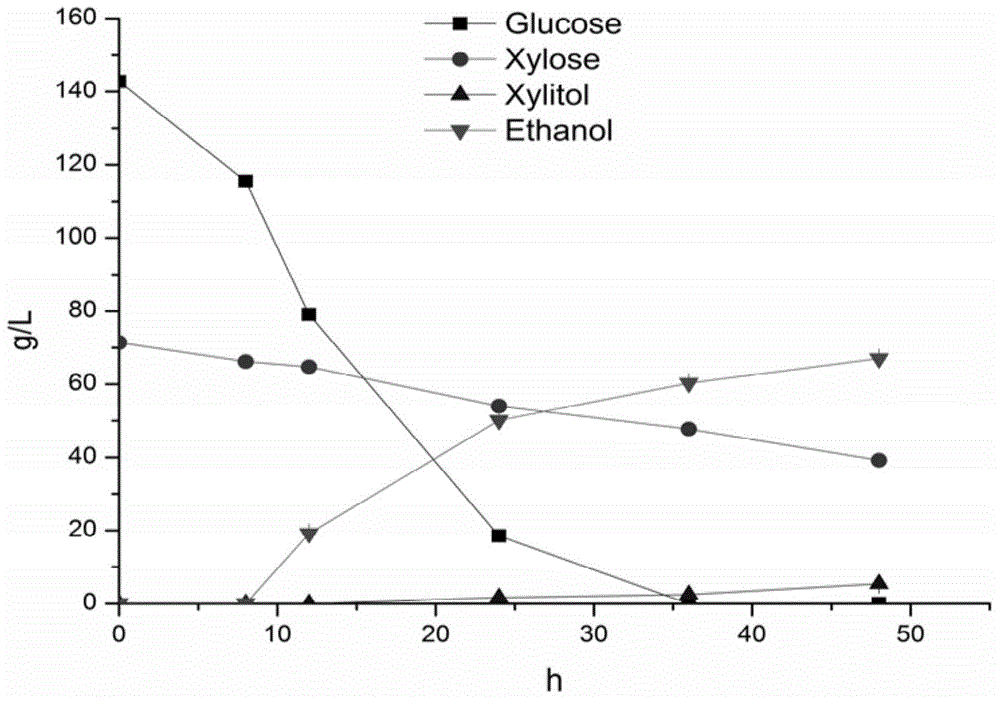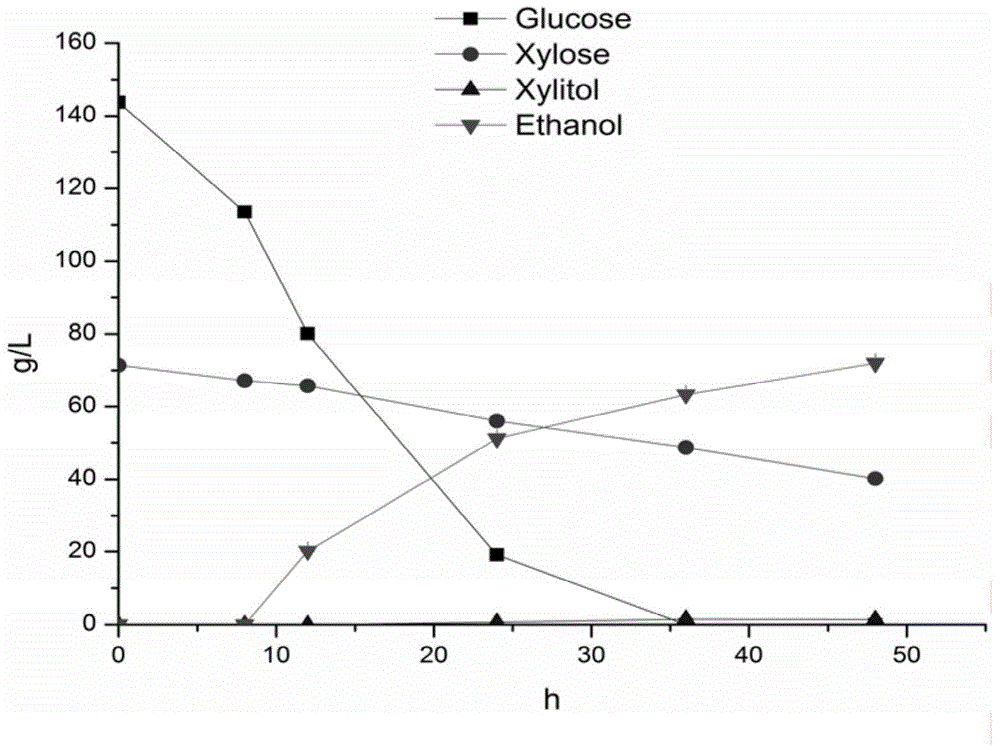Saccharomyces cerevisiae recombinant strain for regulating expression activity of GRE3 genes and application of recombinant strain
A technology of Saccharomyces cerevisiae and genetically engineered strains, applied in the field of genetically engineered strains, can solve the problems of reducing the efficiency of ethanol fermentation of xylose, difficulty in achieving the optimal effect of ethanol fermentation, and the failure of recombinant strains of Saccharomyces cerevisiae to meet the requirements of industrial production, so as to improve growth speed effect
- Summary
- Abstract
- Description
- Claims
- Application Information
AI Technical Summary
Problems solved by technology
Method used
Image
Examples
Embodiment 1
[0053] Knockout of the GRE3 gene in Example 1 Saccharomyces cerevisiae 1308-P
[0054]According to the known GRE3 gene and the nucleotide sequence of the plasmid pUG6, design primers: the design direction is the direction to be amplified, the primer length is 63-64bp, and the annealing temperature is 60-65°C. And they were named knockout 5'GRE3::hphMX, 3'GRE3::hphMX (downstream specific primers) see Table 1.
[0055] Table 1 GRE3 gene knockout and verification primers
[0056]
[0057] The knockout component (1815bp) was obtained by PCR, and the amplified product was gel-recovered and then sent to BGI for sequencing. The sequencing sequence was compared and analyzed, and it was confirmed that the obtained sequence was consistent with the theoretically designed primer sequence.
Embodiment 2
[0058] Example 2 Knockout and modular transformation of Saccharomyces cerevisiae 1308-P
[0059] (1) Activate Saccharomyces cerevisiae 1308-P, wash it twice with sterilized deionized water, add 1ml sterilized deionized water and take 100μl for later use;
[0060] ⑵Put 50μl of salmon essence in boiling water and cook for 10 minutes for later use;
[0061] (3) Take 240 μl of PEG3350 and LiAC36 μl, add the above Saccharomyces cerevisiae, salmon essence and knockout components, vortex and mix well, put them in a water bath at 30°C for 30 minutes, and then put them in a water bath at 42°C for 45 minutes;
[0062] (4) Add 1ml of YPD to culture for 1 hour at 30°C and 120rpm;
[0063] (5) Take 20μl and spread it on the YPD plate containing G418 antibiotic for about 48h to observe.
Embodiment 3
[0064] The above engineering strain of embodiment 3 transforms the excision of pSH65 and Kanr gene (removal of the resistance selection marker in the knockout module)
[0065] (1) Activate the Saccharomyces cerevisiae 1308-P transformed into the knockout component, wash it twice with sterilized deionized water, add 1ml sterilized deionized water and take 100μl for later use;
[0066] ⑵Put 50μl of salmon essence in boiling water and cook for 10 minutes for later use;
[0067] (3) Take 240 μl of PEG3350 and LiAC36 μl, add the above Saccharomyces cerevisiae, salmon essence and knockout components, vortex and mix well, put them in a water bath at 30°C for 30 minutes, and then put them in a water bath at 42°C for 45 minutes;
[0068] (4) Add 1ml of YPD to culture for 1 hour at 30°C and 120rpm;
[0069] (5) Take 20 μl and apply it on the YPD plate containing the antibiotic phleomycin for about 48 hours to observe.
[0070] (6) Culture the strain transformed into pSH65 with YPG med...
PUM
 Login to View More
Login to View More Abstract
Description
Claims
Application Information
 Login to View More
Login to View More - R&D
- Intellectual Property
- Life Sciences
- Materials
- Tech Scout
- Unparalleled Data Quality
- Higher Quality Content
- 60% Fewer Hallucinations
Browse by: Latest US Patents, China's latest patents, Technical Efficacy Thesaurus, Application Domain, Technology Topic, Popular Technical Reports.
© 2025 PatSnap. All rights reserved.Legal|Privacy policy|Modern Slavery Act Transparency Statement|Sitemap|About US| Contact US: help@patsnap.com



